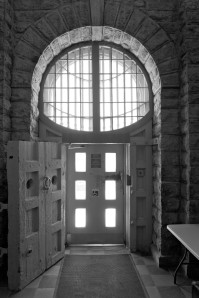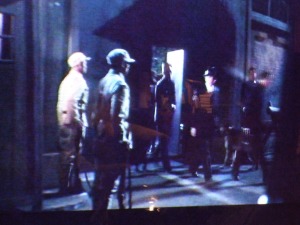Somehow Paula Todd (see “Finding Karla: Fact or Fiction or Both Pt. 1, 2,3) has been elevated by legacy media to a Level One expert on Karla Homolka (a.k.a. Emile Bordelais.)
Since I have now posted thrice critical remarks about Ms. Todd’s anemic effort why am I up on the high horse again?
Because, information, no matter how useless or irrelevant, is like a virus. It’s everywhere and tends to seep to the surface like rocks in a spring field. Like everyone else, I’m overloaded and bemused.
I receive Google Alerts whenever “Karla Homolka” appears anywhere in cyberspace or the press and, a week or two ago, I received a blazing notice from the hinterland that Ms. Todd was going to grace Midland with her presence and be quizzed on her groundbreaking book “Finding Karla.”
The “announcement” was in the Midland weekly newspaper.
Midland is a wealthy little town located on Georgian Bay in Simcoe County, Ontario, Canada. It sits on the south end of Georgian Bay’s 30,000 Islands and is the economic center of the region, meaning everyone for a hundred miles has $$.
Weeklies are delivered up here in the Great White North by an operation called Metro News. I mention this because this blog is about law and disorder (not just about Karla and Paula Todd) and when talking about law and disorder I would be remiss were I not to mention the multi-millionaire owner of Metro News, Alex Petraitis, and his arrest a few years back for conspiring with the ex-husband of his mistress to kill his wife so (according to the Attorney General) he could continue being spanked while wearing diapers by said mistress (who was also practising dominatrix,) in peace.
Mr. Petraitis, a rather gregarious and amiable fellow, in his late sixties at the time, wisely retained my good friend and lawyer Edward L. (Eddie) Greenspan to defend him.
His trial was not only an unbelievable, even hilarious parade of depravity, perversity and incredulity, it was also protracted and mysterious and not to be missed by anyone who’s a fan of that sort of thing and/or a true crime buff. (Here is a link to a relatively comprehensive summary of the case from the National Post.)
I digress. Back to the “Midland Mirror” and Ms. Todd. When I read the following I just lost it: “Paula Todd, the investigative reporter who found convicted killer Karla Homolka living in the Caribbean, will appear at the Midland Cultural Center on Sept. 23 as the next guest in the “A Day in the Life” conversation series.” Slightly naive and behind the curve but that’s life in glorious summer enclaves like Midland.
Again I digress: The blurb goes on: “Investigative reporter Paula Todd is used to asking the tough questions…”
What? Really?
If Ms. Todd is a purveyor of the “tough question,” why the hell didn’t she ask Karla just one when she was allegedly in Guadeloupe sitting right across from her in her living room for an hour?
Oh yeah, I remember now, she was too scared. Remember her pamphlet was suffused with silly sallies about how afraid she was of everything: flying all the way to Caribbean, the island of Guadeloupe because it is French speaking (in spite of the fact that Ms. Todd speaks fluent French), Karla herself, other islanders possibly in Karla’s thrall, like the police and prosecutors were way back when Karla’s was given this future where Ms. Todd finally “found” her.
Even if I did not know Ms. Todd, all this badly written nonsense would be unbelievable. I realize it’s petty but those who know anything about this story will understand why I couldn’t help myself.
Karla, who has lost considerable weight since I last talked to her in prison circa 2002, is a wisp of a girl (a phrase her lawyer George Walker frequently used to describe her when Karla was 20 – 30 lb. heavier, before she went to jail.
She is short, attractive, curvaceous, blonde and petit. On the other hand Ms. Todd is much taller and how shall I say, robust? Ms. Todd takes care of herself. Remember, I have actually spent time in close proximity with both women: Karla while she was in jail and much heavier but still curvaceous and Ms. Todd when she interviewed me (some say attacked – see some of the reader reviews of her e-essay online) a couple of times for the show she co-hosted for a decade on TVO, “Studio Two”. (Full disclosure here: I know Karla much better than I know Paula Todd.)
Karla is about as physically intimidating as a cashmere coat. She is also mild mannered and quite pleasant for the most part. On the other hand, Ms. Todd is much bigger, very self-assured to the point of deliberate intimidation, her perpetual posture particularly when dealing with topics and/or persons she disapproves of.
The newspaper’s squib goes on: “Todd is perhaps best known for tracking convicted killer Karla Homolka, the former wife of multiple murderer Paul Bernardo, to her new home in the Caribbean. The scoop was outlined in her book “Finding Karla…”
I guess the “best known” part is probably true now that everyone has forgotten Paula Todd was on TV virtually every night for two hours for a decade. As I said, I’ve been interviewed on a couple of occasions by Ms. Todd during the years I was writing the definitive books on the case and at least once that I remember while under indictment and I’m 6’4″ and at that time weighed in about 300 lb. Some say I’m intimidating. Paula Todd was not the slightest bit afraid of me. In fact, if I recall, I felt a bit concerned for my well-being.
Now for a few facts for those of us who still care about them: There was no scoop, it wasn’t a book (it was more like a bad essay – today they call it “long form journalism”) and Karla was not pulling a Whitey Bulger – she wasn’t hiding – ergo she could hardly have been “found.”
Anyone who cared to know already knew Karla had been wintering on the island of Guadeloupe, a French protectorate in the Caribbean, since approximately 2007 and spending the summers in Montreal. This was not news. No newspaper editors I spoke to and proposed a little “what’s she doing now?” squib prior to 2012 were the slightest bit interested – in fact, the very opposite. I was told on numerous occasions nobody cared. Karla was yesterday’s news.
Not to suggest that legacy media daily news editors know what they’re doing.
The Americans have never heard of Karla Homolka. Or the French. Or Japanese. Not even the Germans. And those few Canadians who have seem to not be particularly interested in the one thing I find mildly interesting – the fact that Karla moves freely back and forth, wherever she pleases, in the world, across the continent, across the seas, hither and yon.
It would have been interesting to know where else Karla has been or was planning to go but alas Ms. Todd thought that her quest sufficient in and of itself (whether actual or virtual) for such a small pamphlet which appears (since she did not ask any questions at all, let alone tough ones) to have aspired only to lining her and her “editor’s” (the peripatetic Derek Finkle’s) pockets and defraud the reading public.
And contrary to the repeated statements by our (i.e. Canadian) traditional media to the contrary, Ms. Todd is far from the first one, either in digital or physical form, to pull such a stunt and have some modest success with it.
Frankly, if Paula Todd really did go to Guadeloupe (See my earlier posts “Finding Karla: Fraud, Fiction or Both, 1,2,3″) and sat across from Karla for even a few minutes the end product is a bigger indictment of her weaknesses as a writer and an “investigative journalist” than if she made it all up.
Furthermore, contrary to the Midland Mirror squib, an e-essay (it’s even a bit of a stretch to call it a pamphlet) does not a book make. I know that legacy media is very much still engaged in manufacturing consent but this is taking it a bit far, methinks, calling “Finding Karla” a book.
I reiterate because I can: Karla was not lost or on the lamb. She was over 18 and free and she wasn’t under any indictments, or legal restrictions and there were no warrants out for her arrest. The system was finished with her a long time ago. 2015 is the 10th Anniversary of her release from jail (where she resided for 12 long years.) She did the crimes and the time. Hello! She isn’t hiding. She doesn’t have to.
Since the day she was released from prison virtually everyone I know has been mostly aware of exactly where she was at any given moment on any given day because I was. And I was getting my information from other sources. “Finding Karla” was a yawn not a revelation.
Given that Ms. Todd’s short effort at fictional non-fiction was woefully short on real feeling, artifice, opinion and fact I would think she would be too embarrassed to keep up the ruse for so long but apparently not.
While I’m on the subject – for the very last time – I should mention that I’ve seen Ms. Todd pontificating effusively from the medium she loves the most, television, as if she knew everything their was to know about the case in general and Karla Homolka in particular. She was highly visible in two of the recently very poorly conceived and produced hour-long segments made respectively by a British production house called Two-Four for one or another of the many American cable channels surfeit with tales of law and disorder.
The latest (in which I played a very small part but was happy to do so because I was handsomely reimbursed for my time – participating in projects like these can be very time consuming) was made by an operation out of Knoxville, Tennessee called Jupiter Entertainment for “The Oxygen Network” (not available in Canada, mercifully) series “Snapped.” It aired in late August or early September.
Disasters of the fast cut and amateurish awkward reenactments interspersed with a plethora of talking heads (many of whom never knew very much of anything about the case to begin with let alone the only important question it raised – why and how did Karla get away with murder) the programs are misguided, confused, fact-challenged and tedious.
Final words on Ms. Todd and her e-essay: In something so short the least one expects is accuracy – a basic, fundamental familiarity with the facts particularly given that all the facts and the full back story have been out there and easily accessible since 2003. But no. Given what I read the facts do not appear to be relevant to Ms. Todd’s work which means that on it’s face it is without merit and a rip off, even at $2.99. I have seen many reader reviews lamenting that unlike higher priced downloads, there are no refunds at $2.99. Caveat emptor always. Downloaded essays and stories at this price point are more “you pays your money and takes your chances.”
Ms. Todd has just been nominated for a “prestigious nonfiction award” according to a bulletin from the community college where she works: “Independent journalist, lawyer and part-time Seneca professor Paula Todd’s “Extreme Mean” has been nominated for the 2014 Hilary Weston Writer’s Trust Prize for Nonfiction.”
“Extreme Mean,” is a shrill, morally outraged, typical of Todd over-the-ton examination of the growing trend of cyber-bullying and the psychological damage it inflicts on its victims.
Hopefully, this effort contains more facts than fiction. Regardless, it is part of the ongoing onslaught elevating the poisonous culture of victimology in which we live.
Todd has written a blog on her publisher’s website to help promote “Extreme Mean” that in my opinion goes way over the top.
It is in the form of an “open letter” to Robin Williams’ distraught daughter, Zelda (who Todd doesn’t know from Adam) entitled “Why the Internet Needs Zelda Williams.”
Apparently, in the course of “blaming” Ms. Williams for her father’s suicide some extremely mean cyberabusers known as “RIP trolls” posted pictures of a corpse (alleged to be her father’s) with strangulation marks on the neck.
This was understandably unendurable for Zelda Williams and she reasonably stopped tweeting and quit social media altogether.
Todd references the picture of the corps twice in the relatively short blog in which she proclaims solidarity with Ms. Williams, telling her she knows how she feels and pleads with her to reconsider and come back to social media because we “need” reasonable and sensitive people like her?
It seems to me that this kind of posturing has become a trope in Ms. Todd’s oeuvre where by she adopts the mantle of everywoman and then goes on catalogue her empathy and understanding and sympathy while graphically descibing the the bad behaviors she decries.
Here’s an excerpt from the blog: “But how does sending a close up of a strangled corpse (2nd mention of the corpse in the “open letter” to Zelda) to the deceased’s family register protest against public mourning, or “grief tourism,” as it’s called? Are you, Zelda, being blamed for using social media to reach out to shocked family, friends, and fans? Surely, we all have a right—a psychological need, actually—to express our emotions. Your father was a candid veteran of the drug and alcohol wars of celebrity, an intellectual fighting depression and oncoming Parkinson’s, and a man who endured his demons to bring us entertainment. Nothing gives cyberabusers the right to censor any of our reactions to his passing.”
So Paula Todd is qualified to “explain” the world to Zelda Williams and clearly thinks that’s a perfectly reasonable thing to do.
There is something troubling about this. To me, it’s self-serving and opportunistic. But I don’t think I’m expressing myself particularly well. Everyone one is to one degree or another self-serving and opportunistic. Read Ms. Todd’s blog and tell me what you think?












